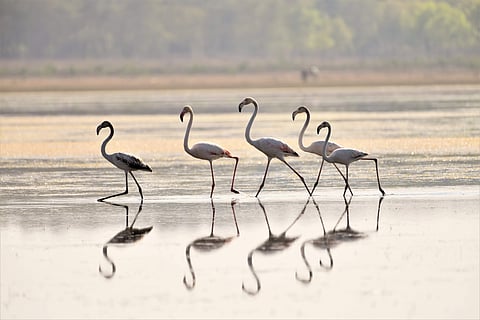

When we called Ashok Kumar Biswal, he was strolling by the Narmada River in Madhya Pradesh. "What a beautiful coincidence," the environmentalist exclaimed! And indeed it was because the passionate explorer and keen-eyed photographer is currently working in and around the river with the US-based The Nature Conservancy. While that project is in its initial stages, we still manage to have a long and languid chat with the 35-year-old photographer because of the body of work he has already established.
Born in Bargarh, Odisha Biswal pursued his Master's in Bioinformatics from Bharathiar University in Coimbatore and knew his heart lies in Odisha. After working with the Wildlife Conservation Society and participating in wildlife census, monitoring and other volunteer work, he finally returned to his home state and joined the Forest Department. One of his first assignments? To explore and document the wetlands and forest areas of Odisha.
Come Naxals in Koraput or Maoists in Sundergarh, Biswal continued to build his inventory because there was just one thought playing on a loop in his mind, 'What if there is no tomorrow?' "I wouldn't miss a chance to explore because I knew that I might not get it again," explains the field researcher. Through his camera lens, he documented several species of flora and fauna between. It was during this expedition, which went on from 2010 to 2015, that he found searsia paniculata, a small tree which was not spotted in Odisha since a very long time and is particularly proud of this achievement. "When I chanced upon it, I felt like it is my humble contribution to documenting Odisha's wildlife," he explains.
After this exciting project, Biswal's next one pushed him to explore not just neighbouring states of Odisha like West Bengal and Andhra Pradesh, but also Bangladesh, Chattisgarh and parts of Jharkhand. And this time, he was documenting the fauna found near wetlands and their ecosystem. "Through my documentation, I wanted people to understand how wetlands contribute to our Earth and why we need to conserve them," says Biswal who has written five books, three on wetlands and flora and two on wildlife. And herein lies his special interest riverbanks, wetlands and the aquatic plants that call it their home. Which is why he is particularly excited about his current project which concerns the Narmada River.
But as we have established before, Biswal's heart resides in Odisha though he remains passionate about the environment everywhere. So will we see him in the coastal state soon? "I do wish to work for Odisha again in the future," he says as we bid him goodbye.
Aquatic flora and fauna as captured by Biswal:
Ottelia alismoides
Commonly known as duck lettuce, it is a freshwater plant that is entirely submerged except the flower
Nymphaea indica
Also known as tropical water lily, these are tender plants which are also cultivated as ornamental ones
Pheasant-tailed jacana
Their preferred habitat are shallow water which is why they have long toes and nail which enable them to walk easily
Sarus crane
This non-migratory bird is the world's tallest flying bird. Their red head and neck makes it easy to distinguish them
For more on him, click on facebook.com/ashok.
